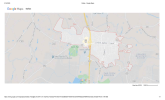In the mostly rural areas I work, a "neighborhood" is often an entire town. Rural property, perhaps more than one school district or even entire counties especially in the case of ranches. And poultry farms, etc. are regional covering more than one state in many cases. "Market Area" makes more sense than "neighborhood." So FNMA's definitions are stupid on the surface. Their admonition "even if this requires more extensive research for particular property types" ignores the fact that to do so takes time and Fannie wants that time to be on your nickel not the clients.
Fannie Mae’s appraisal report forms and guidelines do not require the appraiser to rate or judge the neighborhood. Fannie Mae requires the appraiser to perform an objective neighborhood analysis by identifying neighborhood boundaries, neighborhood characteristics, and the factors that affect the value and marketability of properties in the neighborhood.
- Neighborhood boundaries. The appraiser should provide an outline of the neighborhood boundaries, which should be clearly delineated using ‘North’, ‘South’, ‘East’, and ‘West’. These boundaries may include, but are not limited to streets, legally recognized neighborhood boundaries, waterways, or other natural boundaries that define the separation of one neighborhood from another. Appraisers should not reference a map or other addendum as the only example of the neighborhood boundaries.
- Neighborhood characteristics. These can be addressed by the types of structures (detached, attached) and architectural styles in the neighborhood (such as row or townhouse, colonial, ranch, or Victorian); current land use (such as single-family residential, commercial, or industrial); typical site size (such as 10000 sf, or 2.00 ac); or street patterns or design (such as one-way street, cul-de-sac, or court).
- Factors that affect the value and marketability of properties in the neighborhood. These can be addressed by such things as the proximity of the property to employment and amenities, employment stability, appeal to the market, changes in land use, access to public transportation, and adverse environmental influences.
The appraiser must fully consider all of the value-influencing characteristics in the neighborhood and arrive at an appropriate neighborhood description and opinion of value for the property, even if this requires more extensive research for particular property types or for properties in certain geographic locations.
As for how I search. It is by entire counties in rural counties. In NWA by towns. But the entire MSA where I live (Arkansas) is very uniform in characteristics.... that is, in other words, not uniform. There are no "types" of structures to judge a neighborhood with rare exception. An "natural boundaries" WTF is that? And N, S, E, W are meaningless terms as "neighborhoods" are not square normally and may be gerrymandered like an octopus squished on the road. As for using subdivisions... in cookiecutterville one subdivision may blend into another. And any "complimentary" uses may mean a subdivision with only 1 or 2 sales, or maybe none. But similar homes are probably nearby. So do you encompass several subdivisions or only one? And what is going to happen next with that a-nal UW or reviewer?
In other words, FNMA invites you to practice redlining by arbitrary boundaries that means nothing to a buyer nor the market. Then demands you not use the 'magic' bad words that redlining implies. Our communities, and I suspect that applies to most places I've been, are widely varied with large and small homes, old and new, good roads and bad, and any attempt to artificially pigeon-hole them as "complimentary uses" is a lost cause. So if I use a small town description then it gets the usual bland, rather meaningless and generic boilerplate I create for every town I work and update annually- population, access to jobs, unemployment, etc.

